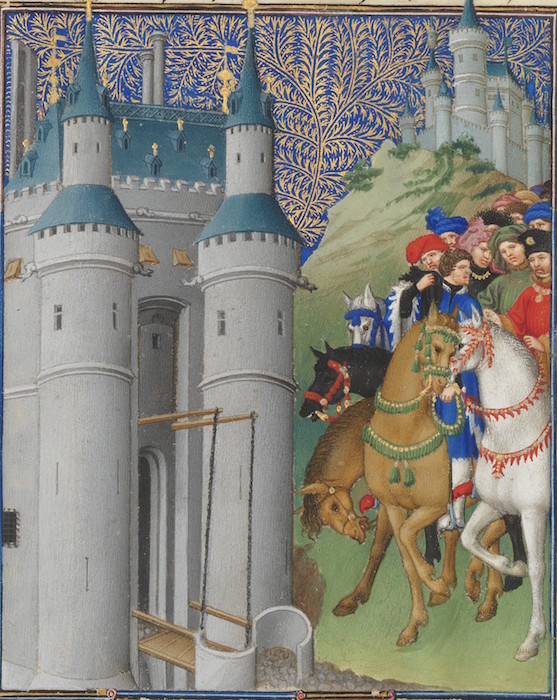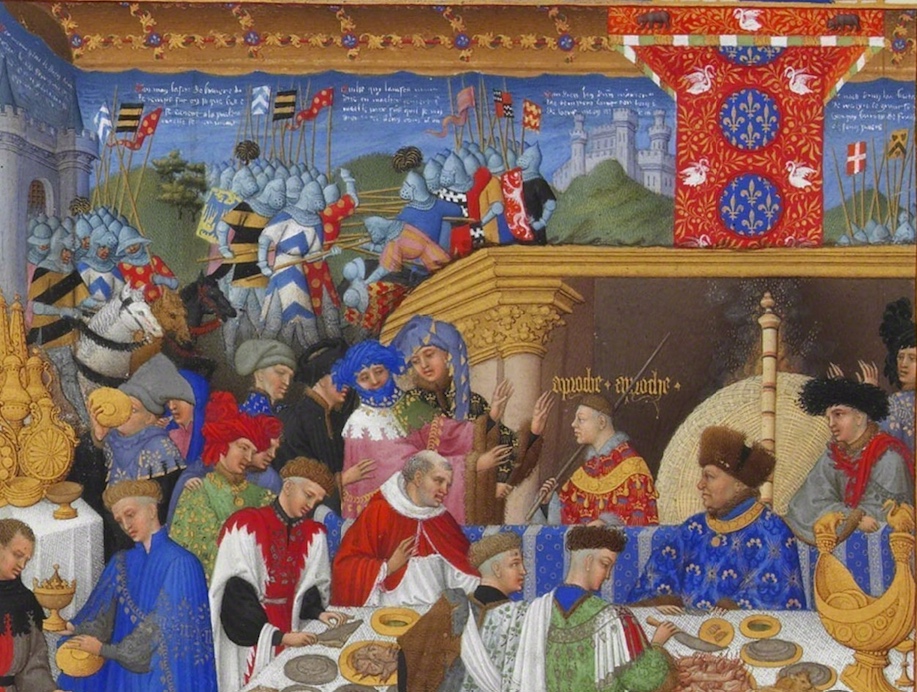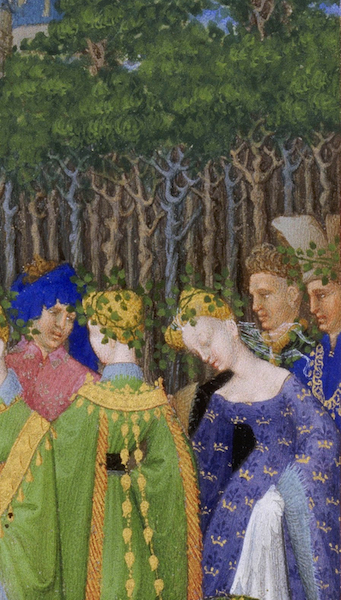
Herman, Paul and Jean de Limbourg, January, from Les Très Riches Heures du Duc de Berry, 1413-16, ink on vellum (Musée Condé, Chantilly). The figure in a blue robe on the opposite side of the table is a portrait of the patron, Jean de France, duc de Berry.
Some background: the Limbourg Brothers
Known collectively as the Limbourg brothers, Paul, Jean and Herman de Limbourg were all highly skilled miniature painters active at the end of the 14th century and the beginning of 15th century. Together, they created some of the most beautiful illuminated books of the Late Gothic period.
The brothers hailed from the city of Nijmegen, currently part of the Netherlands. They came from an artistic family—their father was a wood sculptor, and their maternal uncle was an established painter who worked for Philip the Bold, Duke of Burgundy. From the mid-1400s until the mid-1800s, the brothers’ legacy was lost in the mists of time until a dedicated bibliophile, Henri d’Orleans, duke of Amale, acquired one of their works, the Très Riches Heures, in 1856. This set off a flurry of study around the manuscript and its creators.
Though the exact birth years of the brothers are not known, it is believed that all three died in a wave of plague that hit Europe in 1416. All were likely under 30 years of age, which, though young to the contemporary mind, was a pretty standard life expectancy in the middle ages. Regardless, during their relatively brief lives, they were able to produce a number of complex and remarkable works.
The artistic lives of these brothers (at least Jean and Herman), began when they were sent at a young age to apprentice at a Parisian goldsmith. Apprenticeships—typical for craftsman in the middle ages—generally lasted around seven years. However, these were turbulent times and after only two years the boys were sent back home when a plague epidemic hit Paris in 1399. En route to return home to Nijmegen, they were captured in Brussels, which was experiencing conflict during this period. Jean and Herman were held in a prison for ransom. As their newly widowed mother did not have the funds to pay the ransom, the boys were held for approximately six months. Eventually Philip the Bold, Duke of Burgundy—patron of their uncle Jean—paid half the ransom. Painters and goldsmiths from their hometown contributed the other half. Some scholars believe that upon their release the young men traveled to Italy (though this is highly speculative).
A Moralized Bible
After their release, Philip the Bold commissioned the three brothers to create a miniature bible over a four-year period. Scholars assume this is the Bible Moralisée (Moralized Bible) which currently resides in the Bibliothèque National de France (Ms Fr166)—though this is a matter of some debate.
Bible moralisée, or moralized bibles, are a small group of illustrated bibles that were made in thirteenth-century France and Spain. These books are among the most expensive medieval manuscripts ever made because they contain an unusually large number of illustrations. They books were generally commissioned by members of royal families, as no one else would have been able to afford such luxury. Bible moralisée contain two texts: the biblical text and the commentary text, which is sometimes called a gloss. These commentary texts interpreted the biblical text for the thirteenth century reader. Commentary authors often created comparisons between people and events in the biblical world and people and events in the medieval world.
Their patron: the Duke of Berry
When Philip the Bold died in 1404, the future was uncertain for both the brothers and their uncle, but eventually Philip’s brother—Jean de France, duc de Berry (John, Duke of Berry)—took on the still teenaged boys. They would go on to create the Belles Heures de Jean de France, Duc de Berry, or the “Beautiful Hours of the Duke of Berry,” for him. The story of the Limbourg Brothers is integrally tied to the wealthy and powerful Duke of Berry—a major patron of the arts and avid collector, and the manuscripts they produced for him.
The Belles Heures
The Belles Heures is a Book of Hours— a very popular book to possess during the late medieval period. A Book of Hours is essentially a prayer book (with prayers and readings for set times throughout a day), and it they typically featured the “Hours of the Virgin” (a set of psalms with lessons and prayers), a calendar, a standard series of readings from the Gospels, the Office for the Dead, the Penitential Psalms, and hymns (or some variation thereof). They were miniature works of art made for private use, and generally contained a number of intricate illuminations painstakingly created on vellum (calfskin). A book of hours was for personal, devotional use—it was not an official liturgical volume. Typically, these books of hours were quite petite.

Detail of Folio 223v, “The Duke on a Journey,” Herman, Paul and Jean de Limbourg, The Belles Heures of Jean de France, duc de Berry, 1405-8/1409, tempera, gold and ink on vellum, single leaf: 23.8 x 17 cm (The Cloisters Collection, The Metropolitan Museum of Art)
The Limbourg brothers finished work on the “Belles Heures” around 1409—this was to be their only complete work. The Duke of Berry then commissioned another devotional book in 1411 or 1412, which would become the Très Riches Heures du Duc de Berry (The Very Rich Hours of the Duke of Berry)—probably the best-known example of Gothic illumination.
Though the two manuscripts (the Belles Heures and the Très Riches Heures) were created in fairly close succession, stylistic differences are apparent, and it seems clear that at least one of the brothers (likely Paul as he was the eldest and the master of the workshop), spent some time in Italy studying Renaissance masters such as Pietro Lorenzetti. Whatever the case, there is a change in style—particularly in the way landscapes are depicted and in the decorative borders. This, along with its fine, extant condition, is part of what makes the Très Riches Heures one of the finest examples of Gothic illumination and the International Gothic Style.
The Tres Riches Heures

Detail, Herman, Paul and Jean de Limburg, January, from Les Très Riches Heures du Duc de Berry, 1413-16, ink on vellum (Musée Condé, Chantilly)
In the Très Riches Heures, there are a number of full-page images—including calendar pages. The calendar pages often show agricultural scenes where happy peasants till the fields and harvest. In the background are castles and landscapes that were specific holdings of the Duke of Berry. Likewise we also see the inside the palace. For example, in January (in full at the top of the page, and detail above) we see an image of the Duke himself, sitting at the head of the table while all around presents are exchanged. Likely, the Limbourgs themselves would have been part of this ritual exchange—the man in the mid-ground with the gray floppy cap may be a self-portrait of Paul. The table, resplendent in damask and laden with expensive goods, represents the wealth and taste of the Duke. A variety of heraldic motifs relating to the Duke can also be found, such as the gold fleur-de-lys (in the blue circles above the Duke for example). In the background we see tapestries with a scene of knights emerging from a castle ready to go into battle.

Herman, Paul and Jean de Limbourg, February, from Les Très Riches Heures du Duc de Berry, 1413-16, ink on vellum (Musée Condé, Chantilly)
Meanwhile, the February page takes us outside into the frigid winter air. Wan light falls across a snow covered landscape where in the background we see a town blanketed in snow, along with a peasant and a donkey gamely taking the road towards it. In the middle ground we see another peasant diligently chopping wood, while another hurries towards shelter. In the foreground we see the farm as well peasants warming themselves in a small wooden house. he tunics of both the men are pulled so high, assumedly in an effort to warm their chilled legs, that their nether regions are exposed—something that might strike modern viewers as incongruous to a religious book. At least the lady of the house decorously only warms her ankles! However, nudity in medieval manuscripts, while not prolific, was also not unusual. In fact, there are several other examples that can be found in the “Très Riches Heures.”

Limbourg Brothers, May, from Les Très Riches Heures du Duc de Berry, 1413-16, ink on vellum (Musée Condé, Chantilly)

Limbourg Brothers, May, from Les Très Riches Heures du Duc de Berry, 1413-16, ink on vellum (Musée Condé, Chantilly)
Something else that might strike the modern viewer as curious is the incorporation of the zodiac into this book of hours. For every calendar page, the corresponding astrological sign is shown at the top of the page in a lunette or tympanum. This is in part because the stars were integrally tied to the agricultural calendar. Also, medieval medical practioners believed that people’s health issues were related to what constellation they were born under. Even the church calendar used the Zodiac to calculate feast days. For the month of May (below), we see the astrological signs of the bull and the twins, accompanying the chariot of the sun.
The International Gothic style
The International Gothic style emphasized decorative patterns. This is obvious on the clothing worn by the figures, but even natural forms—like trees—create decorative patterns. Gold leaf, always popular in manuscripts, was also used in abundance. Figures are elegant and elongated. These images are also highly detailed and show an abundant interest in accurately portraying plants and animals. Though the Très Riches Heures, is incomplete, it remains a shining example of the International Gothic style, along with such art works as The Annunciation by Simone Martini and Gentile Fabriano’s Adoration of the Magi.

